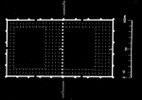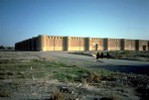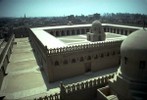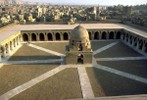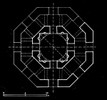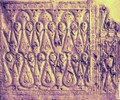Previous Lecture | Next Lecture
Concepts
The Abbasids: The second major Islamic dynasty (750-1258), were the descendants of al-Abbas, the Prophet's uncle, hence the name. Their effective rule lasted only for a little more than a century. After that they became the figureheads of an elusive Islamic unity that did not exist in reality.
Dar al-Salam (the Abode of Peace): The round city founded in 762 by al-Mansur (754-75), the second Abbasid caliph, to be his royal center on the western bank of the river Tigris. Its plan and symbolism were the result of a synthesis of many previous traditions. What started as the enclosed, round city of al-Mansur soon expanded on both banks of the river and its name reverted to that of the ancient name of the site, Baghdad.
Samarra: The new capital city established by caliph al-Mu'tasim in 836 to house his growing army of Turkish slave-warriors (Mamluks) on the Tigris, 60 miles north of Baghdad. It developed into a conglomeration of secluded caliphal palaces and houses for the troops on a grandiose scale. The city remained capital of the Abbasid empire until 883, then it was abandoned and Baghdad regained its old position.
Al-Qata'i' (the wards or the fiefs): the new settlement built north of Fustat on the site of the future Cairo by Ahmad ibn-Tulun, the Turkish governor of Egypt sent by the Abbasids.
Monuments
The Great Mosque at Dar al-Salam: Built by Abu Ja'far al-Mansur in 762, demolished and rebuilt in 808-9, then enlarged in 873-75.
The Great Mosque of Samarra (Mosque of al-Mutawakkil): Founded by caliph al-Mutawakkil (847-61) is the largest mosque in the Islamic classical period (240 by 156 m).
The Mosque of Ibn-Tulun: The furthest westerly evidence of the spread of the Abbasid imperial style. This mosque is distinguished by its combination of columns and piers (eastern and western influences), its spiralling minaret and exclusive dependence on brick as a building material. Its porticos are composed of brick piers with four engaged brick columns which run along its four sides.
The Malwiyya: The famous spiralling, free-standing minaret of the Great Mosque of Samarra. It was repeatedly compared to Mesopotamian Ziggurats.
The Qubbat al-Sulaibiyya: First monumental mausoleum in Islam, built for the caliph al-Muntasir (862).
Stucco Decoration, Samarra Style: A style that tended towards the abstraction of scrolls, stems, and leaves that belonged to the decorative vocabulary of Antiquity. Following the degree of abstraction, three styles have been identified:
- Style A: vine-leave ornament bearing resemblance to the Hellenistic, naturalizing origin.
- Style B: vegetal ornament with some abstraction such as no stalks from which the leaves grow.
- Style C: moulded pattern, very abstract with a combination of vegetal and geometric motifs. Patterns are normally inscribed within borders.

